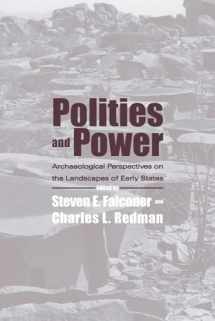
Polities and Power: Archaeological Perspectives on the Landscapes of Early States
ISBN-13:
9780816526031
ISBN-10:
0816526036
Edition:
Illustrated
Author:
Charles L. Redman, Steven E. Falconer
Publication date:
2009
Publisher:
University of Arizona Press
Format:
Hardcover
256 pages
FREE US shipping
Book details
ISBN-13:
9780816526031
ISBN-10:
0816526036
Edition:
Illustrated
Author:
Charles L. Redman, Steven E. Falconer
Publication date:
2009
Publisher:
University of Arizona Press
Format:
Hardcover
256 pages
Summary
Polities and Power: Archaeological Perspectives on the Landscapes of Early States (ISBN-13: 9780816526031 and ISBN-10: 0816526036), written by authors
Charles L. Redman, Steven E. Falconer, was published by University of Arizona Press in 2009.
With an overall rating of 3.7 stars, it's a notable title among other
books. You can easily purchase or rent Polities and Power: Archaeological Perspectives on the Landscapes of Early States (Hardcover) from BooksRun,
along with many other new and used
books
and textbooks.
And, if you're looking to sell your copy, our current buyback offer is $0.3.
Description
This distinctive book is the first to address the topic of landscape archaeology in early states from a truly global perspective. It provides an excellent introduction to—and overview of—the discipline today. The volume grew out of the Fifth Biennial Meeting of the Complex Societies Group, whose theme, States and the Landscape, paid tribute to the work of Robert McC. Adams. When Adams began publishing in the 1960s, the interdependence of cities and their countrysides, and the information revealed through the spatial patterning of communities, went largely unrecognized. Today, as this useful collection makes clear, these interpretive insights are fundamental to all archaeologists who investigate the roles of complex polities in their landscapes. Polities and Power features detailed studies from an intentionally disparate array of regions, including Mesoamerica, Andean South America, southwestern Asia, East Africa, and the Indian subcontinent. Each chapter or pair of chapters is followed by a critical commentary. In concert, these studies strive to infer social, political, and economic meaning from archaeologically discerned landscapes associated with societies that incorporate some expression of state authority. The contributions engage a variety of themes, including the significance of landscapes as they condition and reflect complex polities; the interplay of natural and cultural elements in defining landscapes of state; archaeological landscapes as ever-dynamic entities; and archaeological landscapes as recursive structures, reflected in palimpsests of human activity. Individually, many of these contributions are provocative, even controversial. Taken together, they reveal the contours of landscape archaeology at this particular evolutionary moment.


We would LOVE it if you could help us and other readers by reviewing the book
Book review

Congratulations! We have received your book review.
{user}
{createdAt}
by {truncated_author}


